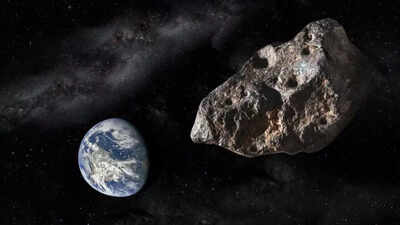Astronomers are closely monitoring a Near-Earth Asteroid Known as 2024 YR4, which has raised concerts to its projectioned trafficory. Initially feared to poses a small risk of striiking earth, recent studies have shown that its chances of colliding with our planet are negligible. However, scientists now warn that 65-metre-bed asteroid carries a measurable risk of impacting the moon in December 2032.The Study Titled “space mission options for reconnaissance and mitigation of asteroid 2024 yr4” preprint survey in ArxivExplors strategies to address the potential impact of asteroid 2024 yr4, which has a 4% chance of striiking the moon in December 2032. The research evaluates varioouted variability options, inconished reconstructions, inconished reconstructions Deflection, and disruption Techniques, to Mitigate the Risks Associated with this Asteroid.
ASTEROID 2024 YRR4 Lunar IMPACT COLD SEND MASSIVE DEBRIS TOWARD EARTH, Threatening Satellites
If Asteroid 2024 YR4 was to Strike the Moon, The Collision Cold Eject a Massive Amount of Debris Into Space. Researchers estimate that the impact might generate a debris cloud weightThis Debris Cold Endanger Satellites and Space Infrastructure for Years, Creacing A Cascade of Collections Similar to the FARERED “Kessler Syndrome.” Meteorite Fragments Raining Down from Lunar Debris could Threten Everything from Communication Satellites to GPS Networks, Making Planetary Defense a Critical Issue.
Scientists plan to break up asteroid 2024 yr4 to prevent a moon
To prevent such a Scenario, Scientists, Including Researchers at Nasa, Are Studying a Bold Solution: Blowing Up Asteroid 2024 Yr4. Their approach, described as a “Kinetic disruption mission,” Involves Using High-Powered Explosive Devices to Fragment The Asteroid Into Smaller, Less Danger Pieces Before It Reachs TheThe proposal builds on the success of nasa’s 2022 double asteroid redirection test (dart), where a spacecraft successfully nudged the asteroid dimorphos off its courses. However, Experts Point Out that 2024 YR4 is Much Larger and Further Away, Making Simple Deflection Techniques Impractical.One of the most serial options under discussion is the use of nuclear explosive devices. Scientists propose sending two 100-kiloton nuclear devices to intercept the asteroid. Each would be five to eight time more powerful than the atomic bombs dropped on hiroshima and nagasaki during world war ii. The first detonation would aim to break apart or deflect the asteroid, While the second device would serve as a backup or be safly detonated in Deep Space If Unuses. Resarchers argue that such a mission could not only protect earth’s satellites but also serve as a blueprint for defending Against Future Space Rocks on a Dearect Collision Course Whith Earth.Executing this plan would be far more complex than past asteroid missions. The asteroid is currently more than 379 Million Miles Away, Meaning that Any Spacecraft would require years to reach it. Estimates sugges that preparation a mission could take five to set to save Pounds, Adds Further Uncertainty, Making Precise Planning Essential.
Preparing for Asteroid 2024 YR4 highlights the need for planetary defense
While the Probability of Asteroid 2024 YR4 Striking The Moon Remains relatively low at just 4 percent, astronomers emphasize the importance of preparation. Unlike Earth-Impacting Asteroids, A Lunar Collision Still Carries Significant Risks for Modern Technology Through Debris Threts.The proposed mission underscores a growing recognition that planetary defense is not just about just about saving lives on earth but also projecting our expert infrasting space infrastructure. Whather Through Nuclear Disruption or other Advanced Techniques, 2024 YRR4 May Serve as a Test Case for How Humanity Responds to Cosmic Threats in the Decades AHEAD.Also read | Nasa parker solar probe sets speed record at 687,000 kilometers per hour during 25th flyby; new insights



